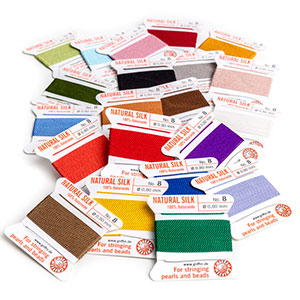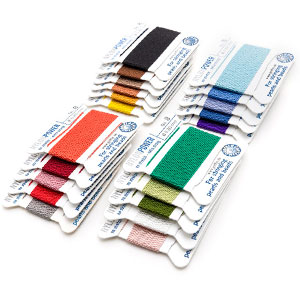
Bead stringing has
been around pretty much for as long as mankind has, and it's set to stay as
popular as ever. We may have moved on from stringing teeth, shells, and stones
on simple leather, but the premise is still the same. We want to show our
precious beads and wares to others on a safely and securely strung piece of
jewellery.
There are numerous
threads and cords available nowadays, all designed for different on and
off-loom work, bead weaving, bead embroidery, and so on. But when it comes to
stringing high-quality or valuable beads (such as pearls, crystals, or
semi-precious), Griffin bead cord has a lion's
share of products to suit this particular style of jewellery.
| Griffin is a family-run
company in Germany and has been around since 1866. For over 150 years, they
have continued their company's fine tradition as a manufacturer and wholesaler
of top-quality bead-stringing materials and jewellery accessories. |
Griffin
manufactures many types of thread and cord, however for our blog today we're
focusing on our three main Griffin thread - 100% Natural Silk, NylonPower and
High Performance.
Whilst silk is wonderfully soft and smooth, Griffin silk thread
is also incredibly strong and has very little stretch. Because of this, it
is a classic stringing material. It is perfect for knotting and creating a
natural drape by following the contours of your body. Griffin 100% natural silk bead cord is made out of the
high-quality centre part of the silk cocoon, which gives the thread a unique
softness and a beautiful lustre.
All Griffin bead threads have a stainless steel needle
already attached, so you don't have to try and thread a tiny needle yourself -
ingenious! |
Whereas silk is the classic choice for stringing, Griffin
Nylon bead cord (NylonPower) is the contemporary alternative. It is an
extremely strong, extra-treated nylon (twice as strong as ordinary nylon). Under tension, Griffin Nylon cord stretches up to 4%,
however once released it returns back to its original state. This is a great
feature for knotting, as it allows you to create knots very precisely, tightly
and permanently.
Remember, all carded bead threads from
CJ Beaders have a stainless steel needle attached, meaning much quicker and
easier stringing - perfect! |
Griffin High Performance Bead Cord Griffin High
Performance bead cord is the strongest of them all. In fact, it is almost
unbreakable, even with the thinnest of diameters. It has high-tech fibres that have an especially dense
molecular structure. They are 15 times stronger than steel and cannot be torn
apart by hand!
The thread is still just as soft and supple as the silk, and
does not stretch over time, so it is the perfect choice for even the hardiest
of stringers! |
You may have noticed from the pictures above that all the
threads mentioned are twisted, and there's a very good reason for that!
All Griffin threads have the precise number of twists under
their optimal tension to prevent fraying, tangling and getting itself knotted.
Griffin prides itself on this mark of quality.
There are 21 available colours and multiple diameters
available in both the 100% Natural Griffin Silk Thread and Griffin Nylon Cord (subject to stock availability).
The colours are based on popular natural gemstone colours,
helping you to match your thread as closely as possible. |
These are the thirteen card numbers and corresponding thread
diameters for both 100% Natural Silk and Nylon Power also. When considering which diameter to pick, you should ensure
the thread easily passes twice through the bead with the smallest hole, to
allow you to finish the thread neatly and securely.
Please note, Griffin High Performance bead cord is only available in White.
It is also available only in 10 different card numbers - 0, 1, 2, 3, 4, 5, 6,
7, 8 and 10. |
You can check the diameter of the bead with the smallest
hole in a few different ways:
1. If you have other bead threads to hand, such as Fireline or Wild Fire,
these have diameters on the spools so can be used as a good gauge for your Griffin
bead cord. If your thread does not have a diameter on it, but it is a common
thread e.g. Nymo, try
Googling some information on it to see if you can source the
measurements.
2. You can try using small bead calipers, however these may
not go as small as you need to get an accurate measurement
3. You may be able to measure the hole by holding a standard
ruler over the bead hole. Although not the most accurate, this should give you
an idea of how wide the hole is
4. Try using needles or bead reamers with different
thicknesses and marking where the bead passes or gets stuck. If a bead gets
stuck, you can carefully remove the bead and measure the diameter of the needle
using a ruler or tape measure. Again, this is not perfectly accurate but you
may find it easier to see than measuring a bead hole
When it comes to the diameter, we would recommend you err on
the side of caution and go with a thinner thread. That way you can always
double your thread or pass through the holes a couple of times, instead of
getting a bead stuck and eventually breaking either the bead, the thread or the
needle.
The next question to ask is "To Knot or Not Knot"?!
We've mentioned a few times about knotting necklaces, but
should you do this? Well, actually yes it is a good idea, especially if you are
using precious or valuable beads. Of course, this also depends on the style of
necklace you're creating, but if you're making a simple strung necklace that
really shows off the quality of the beads, knotting is the way to go and here's
why:
1. A knotted necklace or bracelet is safe and secure. If it
should get caught and break, you may only lose 1-2 bead maximum instead of the
whole lot
2. The knots will stop the beads from rubbing or wearing
against each other, so decreasing the likelihood of damage or even breakage
3. A knotted necklace gives a fantastic drape against the
body and will help to accentuate each and every individual bead
4. When using Griffin bead cord, as there is no real
stretch, your necklace or bracelet will retain its shape over a long period of
time - no gaps will appear between beads and no extra thread will end up
showing around the clasp area over time
If you do choose to knot your design, please remember to
allow double the amount of thread needed for your piece e.g. a 40cm necklace
would need 80cm of thread. Also think about your bead sizes - larger beads
might need slightly less thread as you would need less knots, whereas smaller
beads may need more thread due to needing more knots.
So there we have it, plenty of options for stringing those
lovely beads and keeping them safe. To see our range of Griffin thread, click
the links below…
Bead beautifully!
Show me the Natural Griffin 100% Natural Silk Bead Cord selection
Show me the Griffin Nylon Cord (NylonPower) selection
Show me the Griffin High Performance Bead Cord selection






